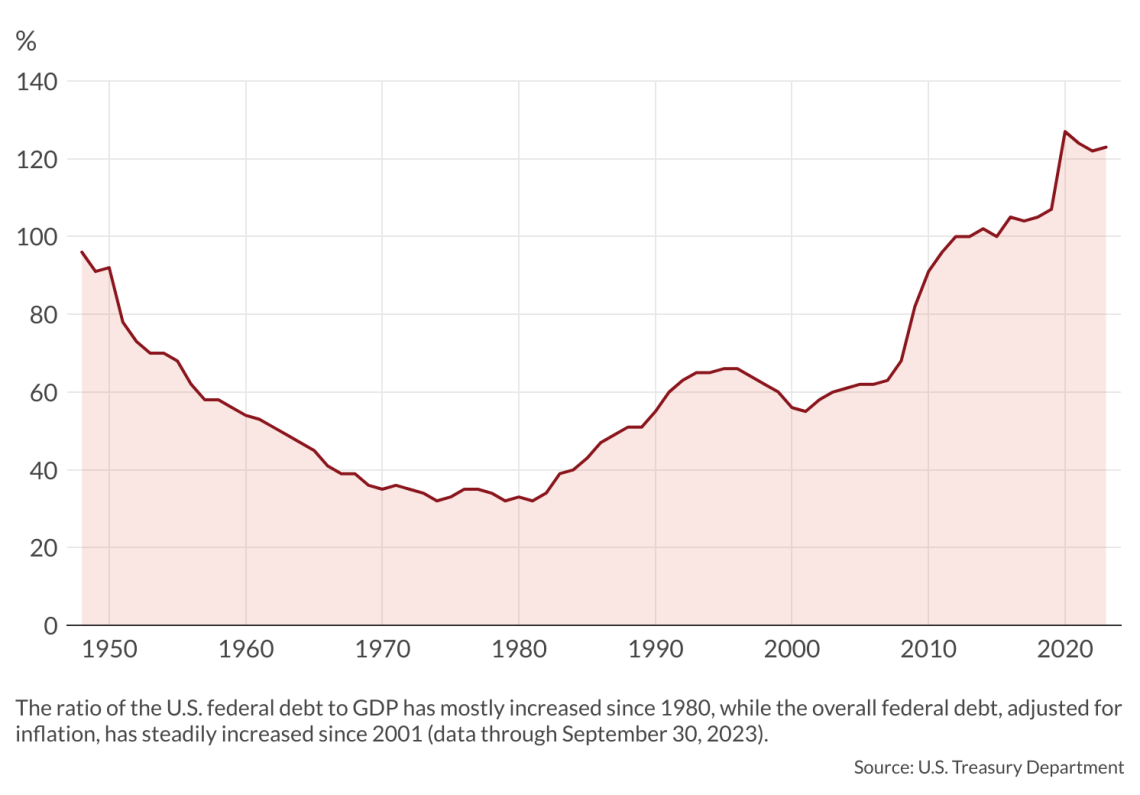Public debt and credit ratings: The American case
The conventional narrative around sustainable debt levels obscures some core challenges staring at United States policymakers.

In a nutshell
- U.S. public debt should not be a cause for immediate concern
- Either higher taxes or inflationary policy will be necessary
- Central banks may end up effectively guaranteeing public debt
Over the past 25 years, total government debt in the United States has increased significantly, from about $10 trillion in 2008 to about $33 trillion in 2023. That is a 130 percent rise, net of consumer price index inflation. The size of the economy has certainly grown as well, but not enough to offset the debt burden. The ratio of debt to gross domestic product (GDP) was 64 percent in 2008, reached almost 130 percent from 2020 to 2022 and is now around 123 percent.
Should one worry? Such concerns are usually associated with “sustainability”: the idea that debt is not a problem as long as it can be effortlessly rolled over – or, put differently, as long as the debtor is able to pay back creditors by creating new debts. If public debt is sustainable, such thinking goes, there is nothing to fear.
Evaluating this belief requires two preliminary comments. First, most policymakers and economists have frequently changed their minds about what level of debt is “sustainable.” Policymakers once believed that the threshold was a 60 percent debt-to-GDP ratio, exemplified in the European Union by a Maastricht Treaty clause that, to this day, has not been amended. However, this has never been taken very seriously. Although some countries do engage in serious efforts to stay within that limit, those who do not are easily forgiven by both markets and international authorities.
Debt-financed public spending can produce a short-term boom in consumption, but eventually, the shortage of fixed capital will take its toll.
Economists also focus on the cost of debt service, excluding the principal. All is supposedly well on the condition that governments maintain a primary budget surplus (the difference between revenues and expenditures, excluding interest on debt). That is said to ensure that at least some share of interest is not paid by issuing new debt. But the underlying logic is fuzzy: while countries running a primary surplus may indeed stand a better chance of stabilizing or cutting their public debt in the future, the mere existence of a surplus is by no means sufficient, especially if interest rates are high and real growth is low.
The message between the lines, one suspects, is that monetary and fiscal policies should serve to keep interest rates low and aggregate demand strong enough to promote growth. Of course, the only way one can expand public expenditure without generating new debt is by creating new money – meaning that the threat of inflation remains real.
The second comment relates to the fact that the very creation and presence of public debt is a burden for the economy. Government borrowing absorbs savings and transforms most of it into (government) consumption. Fewer resources are available to finance investments, with negative consequences for the formation of fixed capital (like machinery and equipment), technological progress and future taxation. In other words, government borrowing stifles productivity and growth. Debt-financed public spending can indeed produce a short-term boom in consumption, but eventually, the shortage of fixed capital will take its toll. If a lack of capital and low productivity reduce growth, then the burden of public debt eventually increases.
Rising debt
In the U.S., the rhetoric of debt sustainability has ensured that high public indebtedness has not been a significant source of concern. Since 2002, the cost of debt financing has been relatively low (the yield on 10-year Treasurys has never been higher than 5 percent) and sometimes even negative in real terms. Moreover, U.S. growth is satisfactory (about 2.5 percent in 2023), and federal tax pressure (around 20 percent of GDP) is significantly lower than in most advanced economies, which means that the federal government could seek to raise revenues if needed.
There is also bad news. Future growth may be less than buoyant, with predictions suggesting about 1 percent growth in 2024 and less than 2 percent in 2025. The cost of debt financing is rising, the so-called inflation tax is now weaker and higher tax pressures could face resistance if the federal taxman tries to crowd out his colleagues at the state level. Markets are also tired of the recurrent risk of default provoked by regular Congressional fights over the debt ceiling, a threat that is less alarming than it seems but still annoying.
Finally, the budget deficit is unusually large, reaching 5.8 percent of GDP in 2022 and rising rapidly. The budget deficit in 2023 will likely land around $1.7 trillion, and net interest payments on public debt are expected to hit $660 billion. This means that the primary deficit is going to exceed $1 trillion – a scary figure that is likely to be even larger in 2024.
Facts & figures
The major credit rating agencies are optimistic despite this mixed picture. Both Standard & Poor’s and Fitch give the U.S. long-term public debt an AA+ grade with a stable outlook, while Moody’s reports an AAA rating (the top mark). However, Fitch’s rating was AAA until early last year, while Moody’s maintained its grade in November but changed its outlook from stable to negative.
In short, notwithstanding the marginal downgrading, U.S. long-term public debt is rated at “very high quality,” better than the British or French public debts and just a hair below that of Germany (which enjoys an AAA rating from all the aforementioned agencies). One can view the revised U.S. ratings as an attempt to signal that the deteriorating budgetary situation has not gone unnoticed – and no more than that.
Questions raised
Given all this, should one start to worry about a forthcoming public debt problem in the United States? The short answer is no. The international agencies still view the U.S. government as a debtor of the highest quality, and financial markets agree: investors continue to buy large quantities of Treasurys. The recent, slightly worse ratings are almost meaningless, only affecting institutional investors obligated to buy strictly AAA-rated securities.
Nonetheless, the excellent reputation of the U.S. as a public debtor raises two questions relevant to future scenarios. One concerns the burden of the federal financial situation. Today, each American bears a public debt of about $100,000 (or $33 trillion “owed” by 332 million people) – twice as much as an Italian and 2.5 times the amount owed by a Greek.
Admitting that American average incomes are also higher than Greeks’ or Italians’, $100,000 is still a lot of money. Since cutting public expenditure will be difficult, higher taxes or a new wave of inflationary monetary policy must be in the cards. Even if the U.S. Treasury remains a safe and rather profitable haven for global investors, American growth prospects are deteriorating, and monetary manipulation will again present a temptation.
Read more by Enrico Colombatto
Fighting inflation without a road map
Inflation has receded somewhat, but central bankers’ ad hoc decisions could have a lasting impact on economic growth and public finance stability.
Financial sustainability will hardly be affected, but Americans should be concerned. Either policymakers will take action, cutting public spending and restoring financial health at the cost of lower growth in the short run – or they kick the can down the road, as growth gradually slows to EU levels and stays there.
The second question regards the role of rating agencies. Since there is no reason to believe that rating agencies know better than financial markets – and given their not-infrequent misjudgments – one may wonder how they are still around. Many passive investment funds today offer their clients sets of securities issued by debtors that are classified according to certified creditworthiness. Fund managers seem unwilling to take responsibility and conduct their own analyses. Many prefer to maintain the appearance of external impartiality, hiding behind international agencies that are blessed with the approval of government regulators.
Scenarios
One scenario that follows could be a story of tacit collusion. Regulators would influence rating agencies to put pressure on chosen governments eager for investment funds and institutional buyers to purchase their securities. The rating agencies would oblige because they are anxious to maintain their status of “impartial” certifier that justifies their existence and fees. In this case, debt sustainability becomes a matter of politics.
But there is another scenario. The difference between an independent and a dependent central bank is tenuous: in both cases, central bankers are appointed by politicians. In the not too distant future, one could imagine central bankers guaranteeing the public debt of selected governments. Such privileged debtors would earn an everlasting triple-A credit rating, effectively by definition.
How would rating agencies respond? On one hand, they would concentrate on non-guaranteed debtors. On the other, their job would entail predicting when central bankers will intervene, how much money they plan to print and how much inflation they will create.
For industry-specific scenarios and bespoke geopolitical intelligence, contact us and we will provide you with more information about our advisory services.









